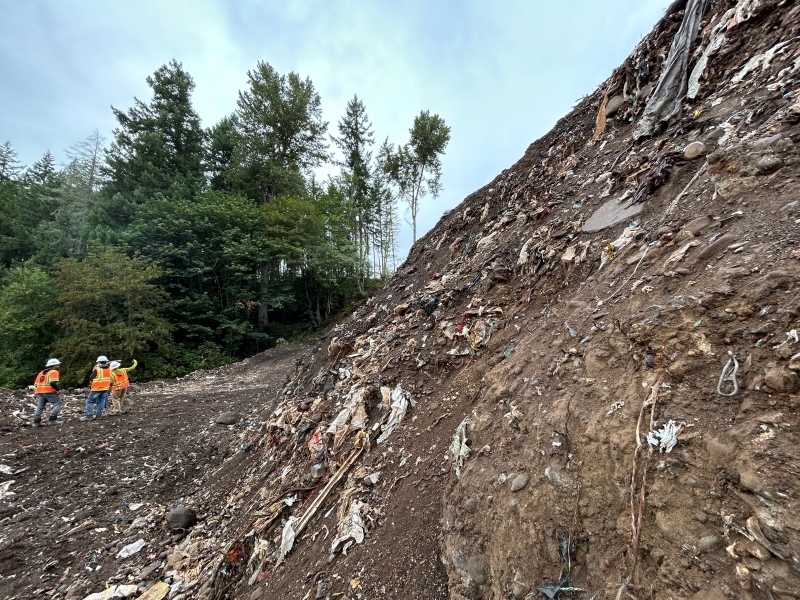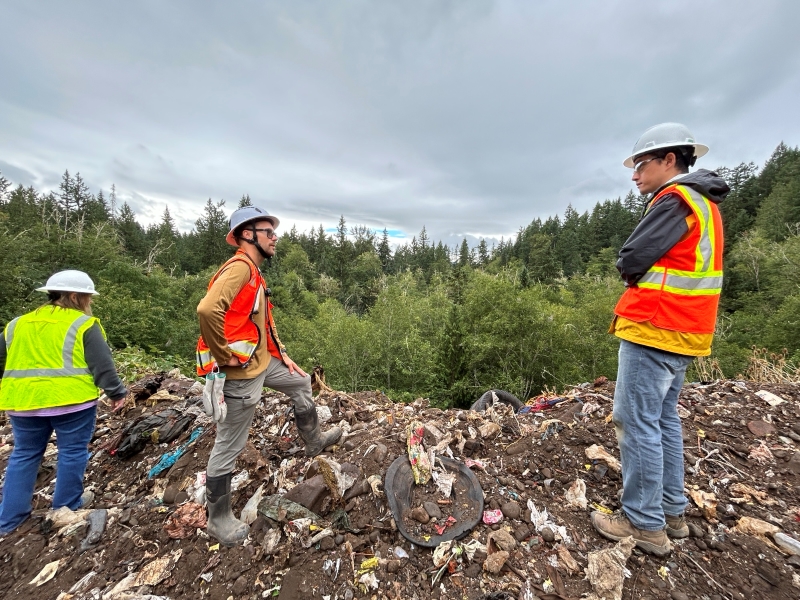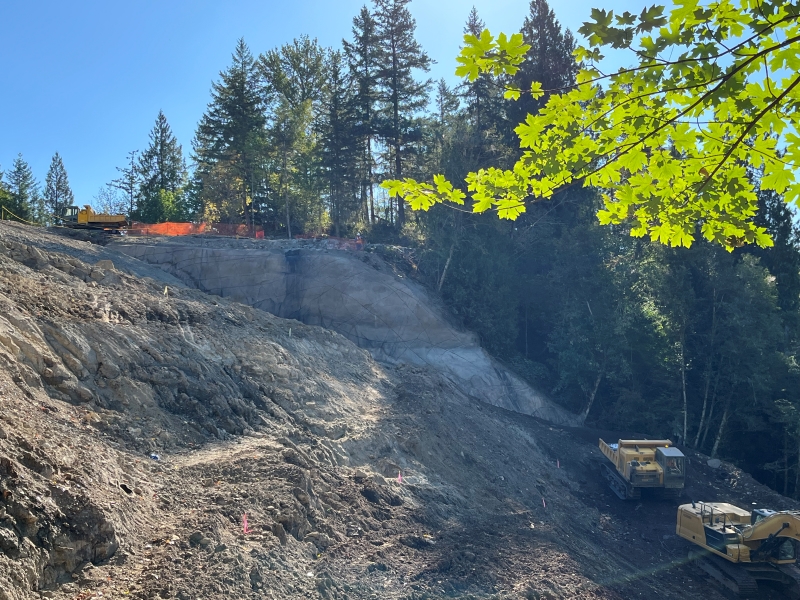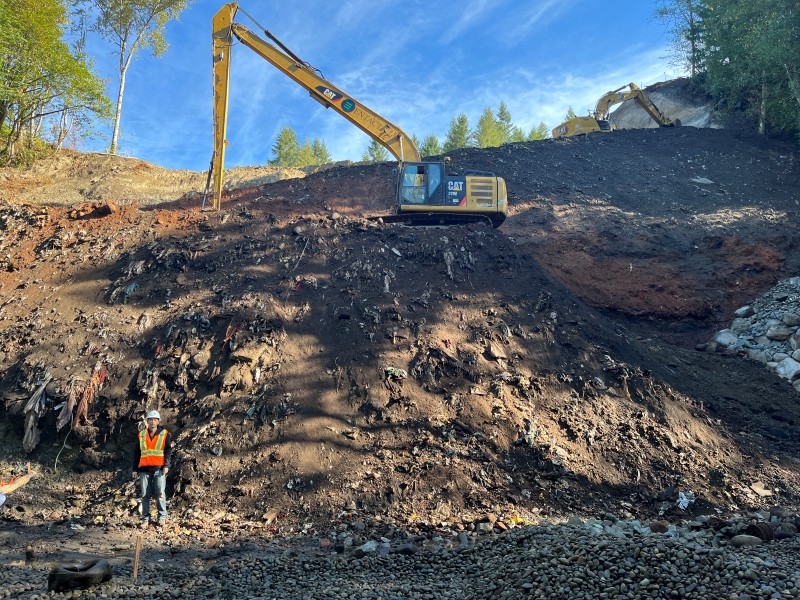
Dozens of tires rest at the bottom of the landfill, landing in the wetland after rolling down the slope. These have been removed as part of the cleanup effort (Ecology photo).
A formerly threatened wetland full of half-buried tires and broken washing machines is getting a facelift after its neighboring landfill area reached an important milestone cleanup this fall.
The almost cleaned-up Eatonville Landfill, a project that’s been in the works for decades, should look indistinguishable from the rest of the new state park it lives in once cleanup crews remove the waste and contaminated soil, followed by re-establishing vegetation in the disturbed area.
The land, owned by timber company Weyerhaeuser and formerly operated by the town of Eatonville as a city landfill, is located within the boundaries of the park Nisqually State Park. The park reopens sometime in 2026 and is Washington’s newest state park in more than 40 years (the park is temporarily closed to complete some construction projects). The project’s $7.4 million cleanup funding for the landfill came from Ecology, thanks to the hazardous substance tax. This was a voter-approved tax authorized by the state’s environmental cleanup law — the Model Toxics Control Act — to pay for cleanups.
Ecology staff and other members of the cleanup crew stand at the bottom of the landfill’s slope assessing the work ahead as half-buried garbage and contaminated soil towers over the team in August 2025 (Ecology photo). 
Planning how to clean up the landfill started in 2021, with debris excavation starting earlier this year. More than 30,000 cubic yards of waste have been removed from the landfill with key collaboration coming from the Nisqually Indian Tribe, Eatonville, Washington State Parks, and Weyerhaeuser. That’s about 1,430 truckloads of contaminated soil and waste, which translates to more than 40,000 tons hauled away.
Legacy of a landfill
The wetland rests at the base of a slope on the south side of the landfill. From the 1950s to 1980, the town of Eatonville leased the land from Weyerhaeuser to dispose of city waste. The unlined and uncovered landfill accepted household waste, car parts, tires, and appliances. Since the landfill was on a slope, large items fell into the wetland and got stuck. Cleanup crews have removed waste from the slope and the wetland, and contaminated soil from the slope. While some of the wetland soil got impacted by petroleum products, the crews will leave the soil alone to naturally degrade. Doing this means the soil isn't disturbed more than necessary and still acts as an effective environmental solution.
Ecology’s Sam Meng stands with others on the edge of a steep drop-off within the landfill during a site visit in August 2025. The contaminated wetland is located below among the trees (Ecology photo). 
Sam Meng, clean-up site manager at the Dept of Ecology, started overseeing the cleanup efforts at the landfill starting in 2022.
“These cleanup efforts will bring a wetland ecosystem that connects to the Mashel River back into balance, which is a large part of Ecology’s mission to preserve the environment for future generations,” Meng said. “We’ve appreciated the efforts, leadership, and contribution from the Nisqually Indian Tribe and cleanup parties to help make this vision a reality.”
Years in the making, the landfill has been waiting a long time for cleanup to start and cleanups can take decades to complete. Even though it’s been four years since Ecology’s role came into play during 2021, the agency considers the last few years of cleanup work and progress to be happening at record speed. One benefit of this is maintaining the cost of the cleanup since each year the cost to store and move contaminated waste typically increases. When done, this cleanup will help the land convert back to a healthy ecosystem.
A new rock wall built to mimic the natural rocks in the area holds back clean soil. Protecting the uncontaminated soil is an important part of the cleanup plan and also improves safety at the site (Ecology photo). 
Since it’s not typical for a landfill to be located on a steep slope like this one, the cleanup crew created an artificial rock wall to hold the clean slide of the slope and limit further contamination from the landfill. The wall is meant to stay forever, which is why the designers made the faux rock look like it could blend with its other rocky surroundings.
A shared collaboration
The Nisqually Indian Tribe been a powerful mover and supporter of the project, and the designated cleanup parties (Eatonville and Weyerhaeuser) were motivated to move quickly. The Tribe has treaty hunting, gathering, and fishing rights in the Nisqually watershed.
Ken Choke, chairman of the Nisqually Tribe, said the health of the Nisqually River and its tributaries, including the Mashel River, is central to the Nisqually Tribe’s identity, culture, and responsibility as stewards of the land. Choke said the Tribe deeply appreciates the work of current and past Tribal Council members and staff, and the collaboration with the town of Eatonville, the Department of Ecology, Washington State Parks, and Weyerhaeuser in honoring this shared responsibility.
“For generations, we have upheld our obligation to protect these waters for the benefit of all who depend on them – human and other-than-human alike,” Choke said. “The cleanup of this long-polluted site marks a meaningful step forward. Together, we are restoring the land, protecting the river, and ensuring that salmon and future generations can thrive. This is what true partnership and environmental justice look like.”
Since 2020, the town of Eatonville has received $7,343,001 from Ecology to pay for its portion of the cost. This includes funding to study the site, compare options for cleanup, prepare key documents and carry out Ecology’s Cleanup Action Plan.
Ecology’s Sam Meng stands in the landfill’s slope to show the scale of the project as a long-reach excavator used for the cleanup rests above him (Ecology photo). 
The site is located approximately 400 feet northwest of the Mashel River, which joins with the Nisqually River about 1 mile downstream from the site.
What's next
Ecology is on the seventh step of the 9-step cleanup process, which state law dictates. The eighth step lasts 10 years and requires Ecology to monitor, maintain, and review the site over time to make sure the cleanup worked. This includes making sure the replanted native plants are growing correctly and that the groundwater and surface water is and stays clean. From there, Ecology gets the chance to remove the site from our suspected and Contaminated Sites List in 2036 as long as the data shows the clean-up plan has worked.

